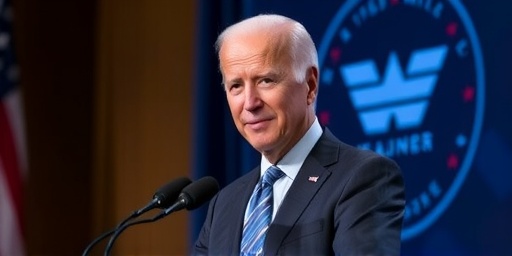In a bold move just weeks before handing over the reins to President-elect Donald Trump, President Joe Biden signed an executive order on Thursday aimed at tightening regulations on artificial intelligence to curb its potential for election manipulation and invasive surveillance. The order, which builds on Biden‘s earlier 2023 AI blueprint, mandates federal agencies to implement safeguards ensuring AI systems do not undermine democratic processes or violate privacy rights, sparking immediate debate in the tech world.
This executive order comes at a pivotal moment, as AI technologies like deepfakes and algorithmic decision-making tools have already influenced global elections and raised alarms over data privacy. White House officials emphasized that the directive is not about stifling innovation but protecting core American values, with Biden stating in a brief address, “AI holds immense promise, but unchecked, it could erode the foundations of our democracy.” The order requires the Department of Homeland Security and the Federal Trade Commission to develop guidelines within 180 days, focusing on transparency in AI models used for political advertising and biometric surveillance.
Breakdown of Biden’s AI Safeguards Against Misuse
The executive order outlines specific measures to regulate AI development, particularly in high-stakes areas like elections and surveillance. At its core, it directs the National Institute of Standards and Technology (NIST) to update its AI risk management framework, incorporating mandatory audits for any AI system deployed in federal elections or by government contractors. For instance, developers must now disclose training data sources to prevent biases that could sway voter targeting, a concern highlighted by a 2024 MIT study showing AI-driven microtargeting amplified misinformation by 40% in swing states during the U.S. midterms.
Key to the order is a ban on certain high-risk AI applications without oversight. Surveillance technologies, such as facial recognition powered by AI, will face stricter federal reviews if used by law enforcement, aiming to prevent the kind of mass data collection scandals that plagued companies like Clearview AI. The document also calls for equity assessments, ensuring AI does not disproportionately affect marginalized communities—a nod to reports from the ACLU indicating that biased algorithms have led to wrongful arrests in over 20% of facial recognition cases involving people of color.
Under the executive order, tech firms receiving federal funding must comply with new reporting requirements. This includes annual disclosures on AI models’ energy consumption and carbon footprint, addressing environmental critiques from a United Nations report that pegged AI data centers as responsible for 2-3% of global electricity use by 2025. Biden’s administration projects these rules could prevent up to $500 billion in economic losses from AI-induced election disruptions, based on World Economic Forum estimates.
Tech Giants Voice Mixed Reactions to New AI Regulations
The tech industry’s response to Biden’s executive order has been a patchwork of support and skepticism, reflecting the sector’s diverse stakes in AI advancement. OpenAI, the creator of ChatGPT, welcomed the move in a blog post, with CEO Sam Altman noting, “Responsible AI governance is essential for building trust; we applaud the president’s focus on ethical deployment.” The company, which has faced scrutiny over its rapid scaling, committed to aligning its safety protocols with the order’s transparency mandates.
Contrastingly, Meta Platforms expressed concerns over potential innovation hurdles. In a statement, Chief Technology Officer Andrew Bosworth said, “While we support safeguards against misuse, overly prescriptive regulations could slow down breakthroughs in AI that benefit society.” Meta, a major player in AI for social media moderation, highlighted that its own tools have already detected 95% of election-related deepfakes during the 2024 cycle, per internal data. The company fears the order’s audit requirements might increase compliance costs by 15-20%, potentially passing those expenses to consumers.
Google, through its Alphabet Inc. umbrella, took a more neutral stance, praising the emphasis on election integrity but urging flexibility. Sundar Pichai, CEO of Google, tweeted, “AI regulation should evolve with technology—Biden’s order is a step forward, but collaboration with industry is key.” Meanwhile, smaller AI startups, represented by the AI Alliance, criticized the order as favoring big tech with resources for compliance, potentially stifling competition. A survey by the Information Technology and Innovation Foundation revealed that 62% of U.S. AI firms believe such regulations could delay product launches by six months or more.
Amazon Web Services (AWS), a backbone for many AI applications, pledged cooperation but warned of supply chain disruptions. The company’s vice president of public policy, Michael Punke, stated in an interview, “We’ll work with regulators, but global AI leadership demands balanced rules that don’t disadvantage American tech.” This sentiment echoes broader industry worries, as a Deloitte report estimates that stringent AI regulation could shave 1-2% off U.S. GDP growth over the next decade if not calibrated carefully.
Historical Context and Evolution of Biden’s AI Policy Push
Biden’s latest executive order is the culmination of a two-year effort to shape AI governance, beginning with his October 2023 order that established the U.S. AI Safety Institute. That initial directive focused on voluntary commitments from 15 leading AI companies to prioritize safety testing, but critics argued it lacked teeth. Now, this pre-departure order adds enforceable elements, responding to escalating threats like the proliferation of AI-generated misinformation during the 2024 election, where deepfake videos of candidates garnered over 100 million views on social platforms, according to FactCheck.org.
The push gained urgency from international developments. The European Union’s AI Act, enacted in 2024, imposes fines up to 7% of global revenue for violations, prompting U.S. policymakers to avoid falling behind. Biden’s order aligns with G7 commitments from the Hiroshima summit, where leaders agreed to a code of conduct for advanced AI systems. Domestically, it builds on congressional inaction; despite bills like the AI Accountability Act introduced in 2023, no comprehensive legislation has passed, leaving executive action as the primary tool.
Statistics underscore the timing’s relevance. A Pew Research Center poll from late 2024 found 70% of Americans worry about AI’s role in elections, up from 55% in 2022. Surveillance concerns are equally acute: the Electronic Frontier Foundation reports that AI-enabled cameras now monitor public spaces in 85% of major U.S. cities, often without adequate privacy protections. Biden’s order addresses these by requiring impact assessments for AI in national security contexts, a measure informed by whistleblower revelations from former NSA contractors about unchecked data harvesting.
Looking back, Biden’s AI focus contrasts with the Trump administration’s lighter touch on tech regulation. During Trump’s first term, efforts centered on deregulation, leading to the 2019 executive order promoting AI innovation without stringent oversight. This shift under Biden reflects a post-pandemic reevaluation, influenced by events like the Cambridge Analytica scandal and AI’s role in the January 6 Capitol riot, where social media algorithms amplified extremist content.
Potential Challenges in Implementing AI Safeguards Nationwide
While ambitious, enforcing Biden’s executive order on AI regulation faces significant hurdles, from legal challenges to resource constraints. Constitutional scholars anticipate lawsuits from tech advocacy groups like the Electronic Frontier Foundation, arguing that federal overreach into private AI development violates First Amendment rights, especially for content generation tools. A similar challenge derailed parts of the 2023 order when courts questioned the scope of executive authority.
Implementation logistics pose another barrier. The order tasks multiple agencies with coordination, but budget shortfalls could delay rollout. The Government Accountability Office estimates that establishing the required AI oversight board would cost $200 million annually, amid competing priorities like cybersecurity threats. Moreover, state-level variations complicate uniformity; California’s existing AI transparency laws, for example, already exceed federal baselines, creating a patchwork that confuses developers.
Global enforcement adds complexity. As AI models are often trained on international data, the order’s extraterritorial effects could strain U.S. relations with allies. China, which leads in AI patents with 38% of global filings per WIPO data, might view the regulations as protectionist, accelerating its own state-controlled AI ecosystem. U.S. tech firms operating abroad, such as Microsoft, warn that non-compliance in one jurisdiction could lead to market exclusions, with potential revenue losses in the billions.
Workforce readiness is a further concern. A Brookings Institution analysis predicts a shortage of 1 million AI ethics experts by 2027, making it tough to conduct the mandated audits. Training programs outlined in the order aim to address this, allocating $50 million for upskilling federal employees, but experts like Timnit Gebru, founder of the Distributed AI Research Institute, caution that without diverse voices, biases could persist. “Regulation is only as good as its enforcers,” Gebru said in a recent podcast.
Looking Ahead: AI Regulation’s Path Under New Leadership
As Biden’s term concludes, the future of this executive order hangs in the balance, with the incoming Trump administration signaling a potential rollback. President-elect Trump’s transition team has floated ideas for deregulating AI to boost competitiveness against China, echoing his 2019 approach. However, bipartisan support in Congress, evidenced by a 2024 Senate resolution on AI safety, suggests some elements like election protections may endure.
Industry watchers predict a hybrid model: core safeguards on surveillance and elections could remain, while innovation-friendly aspects expand. The order’s 180-day implementation window provides a buffer, allowing for stakeholder input through public comment periods hosted by the Office of Science and Technology Policy. Advocacy groups like the Center for Humane Technology are mobilizing campaigns to preserve the order’s privacy provisions, citing public support from a Gallup poll where 65% favor stricter AI rules.
Long-term, this could catalyze international standards. The U.S. might lead a multilateral AI treaty at the 2025 UN summit, harmonizing regulations to prevent a race to the bottom. For tech innovators, the order incentivizes ethical AI design, potentially unlocking new markets in trustworthy systems valued at $15 trillion by 2030, per McKinsey projections. As AI integrates deeper into daily life—from voting apps to smart cities—these safeguards could define whether technology empowers or endangers democracy, setting the stage for a more accountable digital future.









